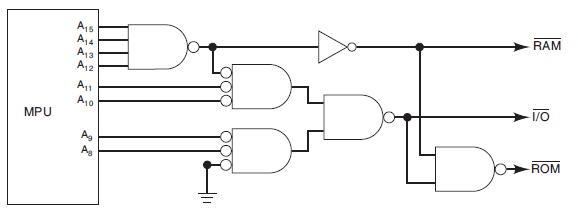Question: In a microcomputer, the microprocessor unit (MPU) is always communicating with one of the following: (1) Random-access memory (RAM), which stores programs and data that
In a microcomputer, the microprocessor unit (MPU) is always communicating with one of the following:
(1) Random-access memory (RAM), which stores programs and data that can be readily changed;
(2) Read only memory (ROM), which stores programs and data that never change;
(3) External input/output (I/O) devices such as keyboards, video displays, printers, and disk drives.
As it is executing a program, the MPU will generate an address code that selects which type of device (RAM, ROM, or I/O) it wants to communicate with. Figure 4-82 shows a typical arrangement where the MPU outputs an eight-bit address code A15 through A8. Actually, the MPU outputs a 16-bit address code, but the low-order bits A7 through A0 are not used in the device selection process. The address code is applied to a logic circuit that uses it to generate the device select signals:
![]() Analyze this circuit and determine the following.
Analyze this circuit and determine the following.
(a) The range of addresses A15 through A8 that will activate R̅A̅M̅
(b) The range of addresses that activate I̅/O̅
(c) The range of addresses that activate R̅O̅M̅
Express the addresses in binary and hexadecimal. For example, the answer to (a) is A15 to A8 = 000000002 to 111011112 = 0016 to EF16.
Figure 4-82

RAM, ROM, and I/O.
Step by Step Solution
3.44 Rating (147 Votes )
There are 3 Steps involved in it
To determine the range of addresses that activate each device RAM IO and ROM we need to analyze the given logic circuit and understand how it generates the device select signals In the given circuit t... View full answer

Get step-by-step solutions from verified subject matter experts


